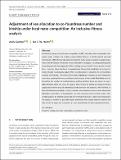Files in this item
Adjustment of sex allocation to co-foundress number and kinship under local mate competition : an inclusive-fitness analysis
Item metadata
| dc.contributor.author | Gardner, Andy | |
| dc.contributor.author | Hardy, Ian | |
| dc.date.accessioned | 2020-11-19T09:30:05Z | |
| dc.date.available | 2020-11-19T09:30:05Z | |
| dc.date.issued | 2020-11-18 | |
| dc.identifier | 270734525 | |
| dc.identifier | 8036689c-d506-4c78-a11a-0871da764768 | |
| dc.identifier | 85096697967 | |
| dc.identifier | 000590170700001 | |
| dc.identifier.citation | Gardner , A & Hardy , I 2020 , ' Adjustment of sex allocation to co-foundress number and kinship under local mate competition : an inclusive-fitness analysis ' , Journal of Evolutionary Biology , vol. Early View . https://doi.org/10.1111/jeb.13719 | en |
| dc.identifier.issn | 1010-061X | |
| dc.identifier.uri | https://hdl.handle.net/10023/21007 | |
| dc.description | AG is supported by a Natural Environment Research Council Independent Research Fellowship (NE/K009524/1) and a European Research Council Consolidator Grant (771387). | en |
| dc.description.abstract | Hamilton’s theory of local mate competition (LMC) describes how competition between male relatives for mating opportunities favours a female‐biased parental investment. LMC theory has been extended in many ways to explore a range of genetic and life‐history influences on sex allocation strategies, including showing that increasing genetic homogeneity within mating groups should favour greater female bias. However, there has been no quantitative theoretical prediction as to how females should facultatively adjust their sex allocation in response to co‐foundress number and kinship. This shortfall has been highlighted recently by the finding that sex ratios produced by sub‐social parasitoid wasps in the family Bethylidae are affected by the number of co‐foundresses and by whether these are sisters or unrelated females. Here we close this gap in LMC theory by taking an inclusive‐fitness approach to derive explicit theoretical predictions for this scenario. We find that, in line with the recent empirical results, females should adopt a more female‐biased sex allocation when their co‐foundresses are less numerous and are their sisters. Our model appears to predict somewhat more female bias than is observed empirically; we discuss a number of possible model extensions that would improve realism and that would be expected to result in a closer quantitative fit with experimental data. | |
| dc.format.extent | 7 | |
| dc.format.extent | 594130 | |
| dc.language.iso | eng | |
| dc.relation.ispartof | Journal of Evolutionary Biology | en |
| dc.subject | Foundress kinship | en |
| dc.subject | LMC | en |
| dc.subject | Parasitoid | en |
| dc.subject | Sex ratio | en |
| dc.subject | QH301 Biology | en |
| dc.subject | DAS | en |
| dc.subject.lcc | QH301 | en |
| dc.title | Adjustment of sex allocation to co-foundress number and kinship under local mate competition : an inclusive-fitness analysis | en |
| dc.type | Journal article | en |
| dc.contributor.sponsor | NERC | en |
| dc.contributor.sponsor | European Research Council | en |
| dc.contributor.institution | University of St Andrews. School of Biology | en |
| dc.contributor.institution | University of St Andrews. Centre for Biological Diversity | en |
| dc.identifier.doi | https://doi.org/10.1111/jeb.13719 | |
| dc.description.status | Peer reviewed | en |
| dc.identifier.grantnumber | NE/K009524/1 | en |
| dc.identifier.grantnumber | 771387 | en |
This item appears in the following Collection(s)
Items in the St Andrews Research Repository are protected by copyright, with all rights reserved, unless otherwise indicated.

